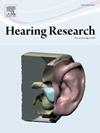Animal models of early-onset hearing loss: A systematic review of the effects on cognition, social behavior, vocalization, and neurobiological mechanisms
IF 2.5
2区 医学
Q1 AUDIOLOGY & SPEECH-LANGUAGE PATHOLOGY
引用次数: 0
Abstract
Hearing loss in children can impair memory, learning, and communication. Despite the need for effective interventions, the mechanisms by which early-onset hearing loss affect cognition, social behaviors and vocalizations as well as the underlying neurobiological mechanisms remain poorly understood. Despite the wide use of animal models to investigate these mechanisms, it is unclear how experimental factors, such as species, hearing loss induction method, severity, onset, and duration, influence outcomes. To address this gap, we conducted a systematic review (PROSPERO: CRD42024515848) to synthesize the fragmented animal literature and clarify how experimental variables shape behavioral and neurobiological outcomes. Studies were identified through a comprehensive search strategy and screened both manually and with AI assistance. Outcomes were analyzed using vote counting and grouped into cognitive, social, vocal, or neurobiological domains. 33 studies met our inclusion criteria, with most focusing on cognitive (n = 20) and neurobiological (n = 15) outcomes and fewer on social (n = 9) and vocal (n = 9) outcomes. Severe hearing loss was most frequently investigated, although induction methods varied widely. Reporting quality was generally poor, often resulting in unclear or high risk of bias. Across studies, hearing loss had negative or neutral effects on cognition and vocalization, and negative, neutral, or occasionally positive effects on social behavior. Experimental parameters did not consistently explain direction of effects within each domain. The most commonly investigated neurobiological mechanisms included oxidative stress, cellular damage, neurogenesis, and neuroplasticity. Our findings highlight the complexity of outcome variability and underscore the need for standardized methods and better reporting to enable robust cross-study comparisons.
早发性听力损失的动物模型:对认知、社会行为、发声和神经生物学机制影响的系统综述
儿童听力损失会损害记忆、学习和交流能力。尽管需要有效的干预措施,但早发性听力损失影响认知、社会行为和发声的机制以及潜在的神经生物学机制仍然知之甚少。尽管广泛使用动物模型来研究这些机制,但尚不清楚实验因素(如物种、听力损失诱导方法、严重程度、发病和持续时间)如何影响结果。为了解决这一空白,我们进行了一项系统综述(PROSPERO: CRD42024515848),以综合零散的动物文献,并阐明实验变量如何影响行为和神经生物学结果。研究是通过综合搜索策略确定的,并通过人工和人工智能辅助进行筛选。结果分析使用选票计数,并分为认知,社会,声音,或神经生物学领域。33项研究符合我们的纳入标准,其中大多数关注认知(n = 20)和神经生物学(n = 15)结果,较少关注社会(n = 9)和声音(n = 9)结果。重度听力损失是最常见的调查对象,尽管诱导方法各不相同。报告质量普遍较差,往往导致不明确或高偏倚风险。在所有研究中,听力损失对认知和发声有消极或中性的影响,对社会行为有消极、中性或偶尔积极的影响。实验参数不能一致地解释每个领域内的效应方向。最常见的神经生物学机制包括氧化应激、细胞损伤、神经发生和神经可塑性。我们的研究结果强调了结果变异性的复杂性,强调了标准化方法和更好的报告的必要性,以实现可靠的交叉研究比较。
本文章由计算机程序翻译,如有差异,请以英文原文为准。
求助全文
约1分钟内获得全文
求助全文
来源期刊

Hearing Research
医学-耳鼻喉科学
CiteScore
5.30
自引率
14.30%
发文量
163
审稿时长
75 days
期刊介绍:
The aim of the journal is to provide a forum for papers concerned with basic peripheral and central auditory mechanisms. Emphasis is on experimental and clinical studies, but theoretical and methodological papers will also be considered. The journal publishes original research papers, review and mini- review articles, rapid communications, method/protocol and perspective articles.
Papers submitted should deal with auditory anatomy, physiology, psychophysics, imaging, modeling and behavioural studies in animals and humans, as well as hearing aids and cochlear implants. Papers dealing with the vestibular system are also considered for publication. Papers on comparative aspects of hearing and on effects of drugs and environmental contaminants on hearing function will also be considered. Clinical papers will be accepted when they contribute to the understanding of normal and pathological hearing functions.
 求助内容:
求助内容: 应助结果提醒方式:
应助结果提醒方式:


